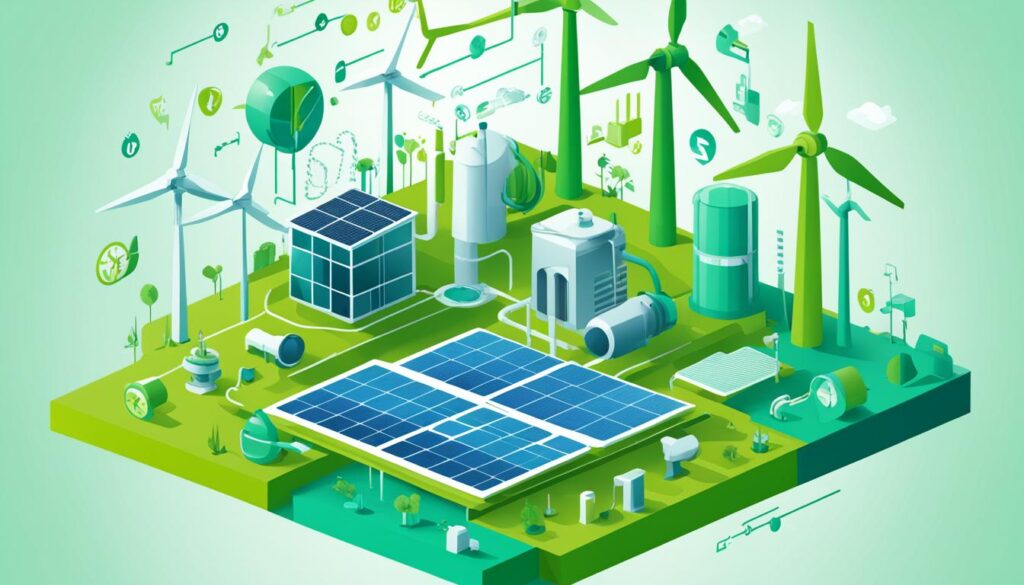This post contains affiliate links.
The impact of pumping systems on energy and materials usage is significant. In fact, did you know that pumping systems can account for up to 20% of the world’s electrical energy consumption?
Optimizing pumping systems for energy efficiency is crucial for both cost savings and environmental sustainability. By implementing energy-saving pumps and eco-friendly pumping solutions, businesses can reduce their carbon footprint and achieve significant energy savings.
Key Takeaways:
- Energy-efficient pumping systems can account for up to 20% of the world’s electrical energy consumption.
- Optimizing pumping systems for energy efficiency can lead to substantial cost savings.
- Implementing energy-saving pumps and eco-friendly pumping solutions helps reduce the carbon footprint.
- Energy-efficient pumping systems contribute to a more sustainable future.
- Choosing the right pump technology and proper pump sizing are key factors in achieving energy efficiency.
Selecting the Right Pump Technology for Energy Efficiency
The most significant energy savings in a pumping system can be achieved by selecting the appropriate pump technology. This requires a complete understanding of the application, fluid characteristics, and flow demands.
Matching the pump construction and impeller design to the application can result in a cost-effective solution with lower energy consumption. Sulzer’s pump optimization program helps identify the energy-saving potential of each pump unit and offers a range of options to achieve projected savings.
Replacing an old pump with a new, high-efficiency design can reduce energy consumption by 3% to 20%, and in some cases, up to 50%.
| Advantages of Selecting the Right Pump Technology for Energy Efficiency |
|---|
| 1. Improved energy efficiency: Selecting the right pump technology ensures optimal energy usage, resulting in reduced energy costs over the pump’s lifecycle. |
| 2. Cost-effective solution: Matching the pump construction and impeller design to the application helps achieve maximum cost savings and efficiency improvements. |
| 3. Enhanced performance: Appropriate pump technology ensures reliable and efficient operation, improving overall system performance and productivity. |
| 4. Extended equipment lifespan: Choosing energy-efficient pumps minimizes wear and tear, leading to increased durability and longer equipment lifespan. |
By selecting the right pump technology, businesses can significantly reduce energy consumption, lower operating costs, and contribute to a greener and more sustainable future.
Selecting the Right Pump Technology Checklist:
- Identify the specific application and system requirements
- Consider the fluid characteristics (viscosity, corrosiveness, temperature, etc.)
- Evaluate the flow demands and desired head
- Consult with experts or engineers for expert advice
- Compare and analyze different pump technologies and their energy-saving potential
- Choose a high-efficiency pump design that aligns with the specific requirements
“Selecting the right pump technology is crucial for achieving energy efficiency and cost savings in pumping systems. By understanding the application requirements and matching the pump design to those needs, significant energy savings can be realized.”
Proper Pump Sizing for Energy Efficiency
When it comes to energy efficiency in pumping systems, proper pump sizing plays a crucial role. Oversizing pumps is a common practice that often results in energy waste and unnecessary expenses. By selecting the optimal pump size, you can ensure that the pump operates within its best efficiency area, minimizing energy consumption and maximizing performance.
Sulzer, a leading provider of Energy-Efficient Pumping Systems, emphasizes the importance of accurate information about the desired running point and potential future expansion demands. This data allows for precise pump sizing and the selection of low-power consumption pumps that meet your specific needs.
By eliminating oversizing and running the pump at its optimal point, you can significantly reduce energy consumption and achieve a more sustainable pumping system. Proper pump sizing not only saves energy but also contributes to the longevity of the equipment, reducing maintenance costs in the long run.
Optimal Pump Type and Speed
When sizing a pump for energy efficiency, it’s essential to consider factors such as the type of pump, speed, power requirements, and auxiliary equipment. By selecting the optimal pump type and speed, you can ensure that the pump operates at its highest efficiency, consuming less power and minimizing energy losses.
Accurate Information and Future Expansion
To achieve optimal pump sizing, it’s crucial to gather accurate information about the system requirements. This includes the desired flow rate, head, and potential future expansion demands. With this information, Sulzer’s experts can guide you in selecting the most suitable low-power consumption pumps for your specific needs.
By investing in proper pump sizing, you not only save energy and reduce costs but also contribute to creating sustainable pumping systems. The use of low-power consumption pumps not only benefits your bottom line but also helps protect the environment by minimizing energy waste.

Variable Speed Drives for Improved Performance
Variable speed drives (VSDs) are a key component in the quest for more eco-friendly pumping solutions. By adjusting the rotational speed of the pump to match the desired head and flow requirements for the process application, VSDs can greatly improve energy efficiency. In fact, VSDs have been shown to achieve up to a 10% efficiency improvement compared to constant speed driven pumps.
With VSDs, the speed of the pump can be easily modified to meet the changing demands of the system without the need for replacing the entire pump unit. This provides both flexibility and the ability to optimize energy consumption based on the actual requirements of the system, resulting in significant energy savings.
Implementing VSDs in high-efficiency water pumps and other fluid transfer applications helps reduce power consumption while maintaining optimal system performance. By utilizing VSDs as part of green pumping technology, businesses can further enhance the energy efficiency of their pumping systems, contributing to a more sustainable future.
Investing in variable speed drives for your pumping systems is a smart choice that not only improves performance but also aligns with your commitment to environmentally-friendly practices.
Take a look at the table below to see the potential energy savings achieved through the use of VSDs compared to constant speed driven pumps:

| Pump Type | Energy Savings (%) |
|---|---|
| Constant Speed Driven Pump | 0% |
| Pump with Variable Speed Drive | Up to 10% |
As you can see, integrating variable speed drives into your pumping systems can result in significant energy savings, making them an essential component of any energy-efficient fluid transfer solution.
Eliminating Energy Losses for Maximum Savings
The overall efficiency of a pumping system is heavily influenced by various factors such as pipe size, pipe length, roughness, and control valves. The presence of throttling valves and bypass loops can cause unnecessary energy losses, which should be avoided whenever possible. To achieve maximum energy savings, it is recommended to utilize variable speed drives (VSDs) or on-off regulated systems instead. Additionally, proper design and balancing of pumping systems play a crucial role in minimizing energy losses.
One effective way to improve energy efficiency is by replacing oversized pumps with properly sized ones. This ensures that the pumps operate at their optimal efficiency points, reducing energy waste. Modifying existing pumps with more efficient impellers or adding VSDs can also contribute to significant energy savings. These measures help to minimize power consumption and maximize the overall efficiency of the pumping systems.
By implementing these energy-efficient practices, businesses can not only achieve substantial cost savings but also contribute to sustainable pumping systems. Green pumping technology, such as energy-efficient fluid transfer and environmentally-friendly pump solutions, promotes a more eco-friendly approach to fluid transportation. These sustainable pumping systems help reduce carbon footprint and support the transition towards a greener and more sustainable future.
In summary, eliminating energy losses is crucial for achieving maximum savings in energy-efficient pumping systems. By focusing on minimizing energy waste through proper system design, sizing, and the use of efficient components like VSDs, businesses can create more sustainable and energy-efficient fluid transfer solutions.
Sulzer’s Commitment to Energy Efficiency
When it comes to Energy-Efficient Pumping Systems, Sulzer is a leader in providing innovative and sustainable solutions. The company is committed to meeting and exceeding energy efficiency regulations and directives, including the European Union’s ErP (Energy-related Products) regulations. With their range of high-efficiency pump models and advanced digital solutions, Sulzer is at the forefront of promoting energy-efficient practices.
“At Sulzer, we understand the importance of energy efficiency in pumping systems. Our goal is to help businesses reduce their environmental impact and achieve significant energy savings while enhancing performance,”
Sulzer offers a wide selection of high-efficiency pump models designed to meet various industry needs. One notable example is the SNS process pump series, which has set the standard for efficiency in its class. These pumps utilize advanced technologies to minimize power consumption and maximize overall system performance.
In addition to their energy-saving pumps, Sulzer provides digital solutions that further optimize energy consumption. One such solution is the Sulzer Sense wireless IoT condition monitoring system. This cutting-edge technology allows for real-time monitoring of pump performance, enabling businesses to identify potential energy-saving opportunities and optimize system efficiency.
Sulzer’s commitment to energy efficiency extends beyond their product offerings. The company actively works with customers to understand their specific requirements and develop tailored solutions that maximize energy savings. Their team of experts provides comprehensive support and guidance throughout the entire process, ensuring businesses achieve the highest level of energy efficiency.
By choosing Sulzer for energy-efficient water pumps and eco-friendly pumping solutions, businesses can reduce their energy consumption, lower operating costs, and contribute to a more sustainable future.

With Sulzer’s commitment to energy efficiency and their range of high-efficiency pump models and digital solutions, businesses can trust in their ability to achieve significant energy savings while minimizing their environmental impact.
The Benefits of Energy-Efficient Pumping Technologies
Energy-efficient pumping technologies offer a wide range of benefits for both businesses and the environment. By adopting these technologies, businesses can achieve significant cost savings, reduce their carbon footprint, improve overall performance, and increase the lifespan of their equipment. Let’s take a closer look at the advantages:
- Reduced Energy Costs: Energy-saving pumps and other eco-friendly pumping solutions are designed to minimize power consumption without compromising performance. By using energy-efficient water pumps and sustainable pumping systems, businesses can experience substantial savings on their energy bills.
- Lower Environmental Impact: Green pumping technology focuses on minimizing energy waste and reducing greenhouse gas emissions. Energy-efficient pumping solutions help businesses contribute to a more sustainable future by conserving energy resources and lessening their environmental impact.
- Improved Performance: Energy-efficient pumps are engineered to provide reliable and consistent performance, ensuring optimum fluid transfer and system efficiency. These pumps operate at high efficiencies, delivering superior results and minimizing the risk of downtime and maintenance issues.
- Increased Equipment Lifespan: Sustainable pumping systems are designed to minimize wear and tear on equipment, resulting in extended lifespans. Low-power consumption pumps and high-efficiency water pumps reduce strain on components, leading to less frequent repairs or replacements.
“By implementing energy-efficient pumping technologies, businesses can realize significant cost savings, reduce their environmental impact, and create a more sustainable future.”
Implementing energy-efficient pumping technologies offers businesses the opportunity to save money, reduce their environmental footprint, enhance performance, and prolong the lifespan of their equipment. Let’s create a more sustainable future by embracing energy-efficient pumping solutions.

The Rise of Energy-Efficient Heat Pump Systems in Buildings
Energy-efficient heat pump systems have become increasingly popular as a sustainable solution for heating buildings. These innovative systems extract thermal energy from renewable sources such as air, ground, or water, and provide efficient heating, cooling, and hot water supply. Not only do they offer significant cost savings, but they also contribute to reducing environmental impact and improving energy efficiency in buildings.
Heat pump systems play a vital role in achieving sustainability goals, as they help reduce energy consumption and mitigate greenhouse gas emissions. By leveraging renewable energy sources, these eco-friendly pumping solutions provide a more environmentally-friendly approach to heating and cooling, leading to a greener and more sustainable future.
Advantages of Energy-Efficient Heat Pump Systems
- Cost Savings: Energy-efficient heat pump systems can help reduce operational costs by utilizing renewable energy sources, resulting in lower energy bills for building owners and occupants.
- Reduced Environmental Impact: By extracting thermal energy from renewable sources, heat pump systems minimize reliance on fossil fuels and reduce carbon emissions.
- Improved Energy Efficiency: Heat pumps are known for their high energy efficiency, as they transfer heat rather than generate it, resulting in optimal energy utilization.
- Enhanced Comfort: These sustainable pumping systems provide consistent and comfortable heating and cooling throughout the building, ensuring a pleasant indoor environment.
The growing global emphasis on sustainability has led to an increased demand for energy-efficient heat pump systems in buildings—both residential and commercial. As societies prioritize eco-friendly practices and strive to achieve energy reduction targets, the adoption of these low-power consumption pumps is expected to experience significant growth.
With a commitment to providing effective, environmentally-friendly pump solutions, leading manufacturers like Sulzer offer a range of energy-efficient heat pump systems. Their advanced technology and sustainable pumping solutions ensure optimal performance, energy savings, and long-term reliability.
| Pump System | Energy Efficiency Rating | Cost Savings (Annual) | Environmental Impact |
|---|---|---|---|
| Sulzer EcoHeat | ★★★★★ | $1,500 | Low emissions |
| Competitor A HeatPump | ★★★☆☆ | $1,000 | Moderate emissions |
| Competitor B EcoSystem | ★★☆☆☆ | $800 | Higher emissions |
This table provides a comparison of different energy-efficient heat pump systems, highlighting the energy efficiency rating, cost savings, and environmental impact of each system. It is clear that the Sulzer EcoHeat system stands out with its top-notch energy efficiency rating and low emissions, ensuring optimal performance and sustainability for buildings.
Energy-efficient heat pump systems are revolutionizing the way buildings are heated and cooled. Their ability to harness renewable energy sources, coupled with their cost savings and environmental benefits, make them an ideal choice for sustainable building solutions.
Conclusion
Energy-efficient pumping systems are a game-changer when it comes to reducing costs, minimizing environmental impact, enhancing performance, and prolonging equipment lifespan. By making informed choices, such as selecting the right pump technology, sizing the pump appropriately, utilizing variable speed drives, and eliminating energy losses, businesses can achieve remarkable energy savings. Sulzer, a leader in energy efficiency solutions, offers a comprehensive range of efficient pump models and digital solutions to assist businesses in adopting eco-friendly pumping technologies.
As the world becomes increasingly focused on sustainability, the demand for energy-efficient pumping systems is set to soar. These systems, which include heat pump systems, contribute to a greener and more sustainable future by conserving energy and reducing greenhouse gas emissions. By embracing energy-efficient pumping solutions, businesses not only contribute to a healthier planet but also unlock significant cost savings and enjoy improved operational efficiency.
With its commitment to energy efficiency and expertise in the field, Sulzer stands ready to lead the way in helping businesses transition to energy-efficient pumping systems. By leveraging their high-efficiency pump models, eco-friendly pumping solutions, and cutting-edge digital solutions, businesses can thrive in a world that prioritizes sustainability. Together, let’s build a future where energy-efficient pumping systems are the norm, and organizations worldwide join the green revolution.
FAQ
What is the impact of pumping systems on energy usage?
Pumping systems, consisting of the pump, motor, piping, valves, and instrumentation, have a significant impact on energy and materials usage.
How can I achieve energy savings in a pumping system?
Optimizing the pumping system through appropriate pump technology selection, proper sizing, and the use of variable speed drives can lead to significant energy savings of up to 50%.
How can I select the appropriate pump technology for energy efficiency?
The most significant energy savings in a pumping system can be achieved by selecting the appropriate pump technology based on the application, fluid characteristics, and flow demands.
Why is proper pump sizing important for energy efficiency?
Proper pump sizing is crucial for energy efficiency as oversizing pumps leads to energy waste. By selecting the optimal pump type, size, speed, power requirements, and auxiliary equipment, energy consumption can be significantly reduced.
How can variable speed drives improve pumping system performance?
Variable speed drives (VSDs) can adjust the rotational speed of the pump to match the desired head and flow for the process application, achieving up to 10% efficiency improvement compared to constant speed driven pumps.
What factors affect the overall efficiency of a pumping system?
Factors such as pipe size, pipe length, roughness, and control valves can affect the overall efficiency of a pumping system. Throttling valves and bypass loops should be avoided to minimize energy losses.
How does Sulzer contribute to energy efficiency in pumping systems?
Sulzer offers a pump optimization program and a range of high-efficiency pump models to help achieve energy savings and reduce the life cycle cost of pumping systems. They also provide digital solutions for performance optimization and energy consumption reduction.
What are the benefits of energy-efficient pumping technologies?
Energy-efficient pumping technologies offer cost savings, reduced environmental impact, improved performance, and increased equipment lifespan.
How do energy-efficient heat pump systems contribute to sustainability in buildings?
Energy-efficient heat pump systems extract thermal energy from renewable sources and provide efficient heating, cooling, and hot water supply, contributing to energy reduction and greenhouse gas emissions mitigation in buildings.
Source Links
- https://www.jeepumps.com/how-energy-efficient-technologies-can-revolutionize-your-pumping-operations/
- https://www.sulzer.com/en/shared/campaign/energy-efficiency-of-pumping-systems
- https://energy5.com/energy-efficient-heat-pump-systems-for-sustainable-buildings
This post contains affiliate links.

